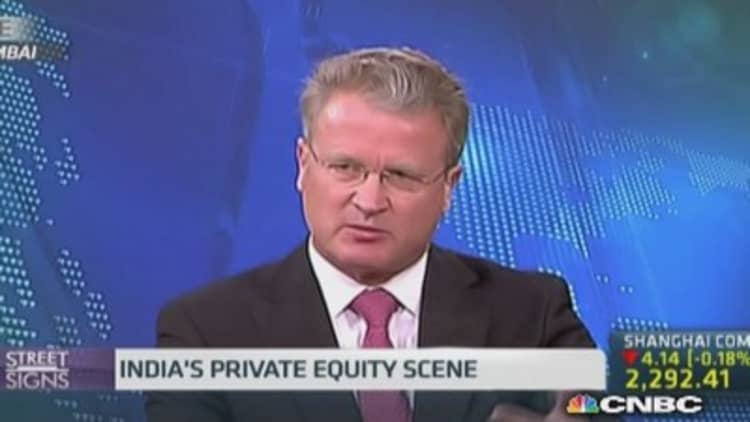Singaporean Thomas Ong, a director at a local private equity firm, recently got invited as a guest lecturer at a private college in Jaipur, India. "I had heard stories about India's young people with 'excellent academic and English speaking skills' but what I encountered was the complete opposite," he said.
Not one student in a class of 100 has ever heard of Bill Gates or Warren Buffet. Most students could not understand, let alone speak fluent English. "The only question they had at the end the lecture was how to find a job at home or abroad," Ong said.
His account is anecdotal evidence of what human resource experts, corporate leaders and countless surveys have been highlighting over the past few years – that despite India's huge talent pool of graduates, few are equipped with skills to be gainfully employed.
Read MoreCan India offer an Ivy League education?
According to a survey conducted by Aspiring Minds, an entrepreneurial initiative in preparing youth for employability, as many as 83 percent of graduating engineers in 2013 could not find jobs, given their poor English language and cognitive skills.
In fact, only 2.6 percent of graduates in India were recruited in functional roles like accounting, 15.9 percent in sales-related roles and 21.3 percent in the business process outsourcing sector. "Nearly 47 percent of Indian graduates are unemployable in any sector, irrespective of their academic degrees," noted Varun Aggarwal, co-founder and COO of Aspiring Minds.
The statistics run counter to the perception that India's relatively youthful population could help reap demographic dividends for the country down the line.
Read MoreIndia's growth speeds up in after-glow of Modi's triumph
In 2020, the average Indian will be only 29 years old, compared to 37 in China and the U.S., 45 in West Europe and 48 in Japan, according to India's Ministry of Labor and Employment. By 2030, India's 1.5 billion population will have 68 percent men and women in the working age of 15-68, compared with 65 percent today.
Theoretically, a nation with young demographic has lower dependency ratio, which leads to increased consumption that can be channeled into higher investment and therefore growth.
For India however, the reality on the ground couldn't be more different. "It is not unusual to see graduates employed as security guards, driver or waiters in restaurants, given the poor standards of education. So what demographic dividend are we talking of? The generation coming of age in the 2010s faces the greatest underemployment ever in history," said Anil Sachdev, a human resources specialist and career coach.

Read MoreAre China-India ties entering a new chapter?
The fault appears to lie in the dismal education standards in India. As little as 10- 12 percent of the 15-29 year-old age group in India receives any formal or informal training compared with to 28 percent in Mexico or 96 percent in South Korea.
For tertiary education, none of the 42 central universities in India feature in the most recent QS list of best 200 colleges in the world. In the rankings of the best MBA schools by the Financial Times, the prestigious Indian School of Business has fallen six places to the 36th spot this year and Indian names are conspicuously missing in the top 25 places.
Analysts say a lack of occupational focus in the degrees offered by local universities could be partly to blame. Some 82 percent of the enrolment is in arts, sciences and commerce programs rather than specific skill-based courses. Even among the engineering and management colleges, less than 25 percent can apply theoretical knowledge to functional areas, given the emphasis on rote learning and theory in the education system, says Aggarwal. The situation progressively deteriorates moving into the tier 2-3 towns from the metros.
Read MoreWith eye on China, Modi's India to develop disputed border region
"Excessive government regulation, outmoded curricula and a drop in the standards of teaching have led to a deterioration in the standards of education so much so that India's demographic dividend may well turn out to be a demographic disaster," said Pramath Sinha, co-founder of the new-age Ashoka University and ex-dean of Indian School of Business, the country's first public private initiative to bridge jobs and employability gap.
Systemic risk?
According to the World Economic Forum's 2014 Global Risk Report, high youth unemployability raises the risk of social instability and hampers economic growth. Analysts fear this is playing out in India.
The planning commission has estimated that the country needs 500 million skilled laborers in the next 5-7 years to support economic expansion, compared with the current capacity of 3.1 million.
Read MoreFocus on Rape in India Ignores Gender Violence as a GlobalTragedy
It's a mind-boggling ambition, India watchers say, given that most state governments do not have the budget, will or capabilities to build the required education infrastructure. Private initiatives, meanwhile, are stymied by archaic socialist laws that ordain that education be a 'not-for-profit' activity. While colleges have mushroomed in the country, the learning outcomes are so poor that they have developed an infamous reputation for being ill-respected teaching shops that dispense degrees on the tap.
"It is the biggest scam in history where political money has found its way into institutions of higher learning. While world over the government's role is focused on learning outcomes, in India the focus is on political controls in the name of 'not-for- profit. Urgent education reforms is the need of the hour," said Sachdev.
The poor education standards are recipes for social problems as incidents of crime escalate, added Sinha.
"The consequences could be huge if no action is taken. Already we are seeing an increase in violence, rape and crime in states like Uttar Pradesh and Bihar. If more than two-thirds of the youth don't realize their economic potential, how can a nation achieve its growth targets? Trouble is no one seems to be paying heed," he said.




